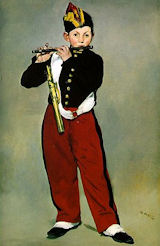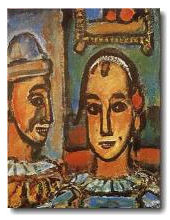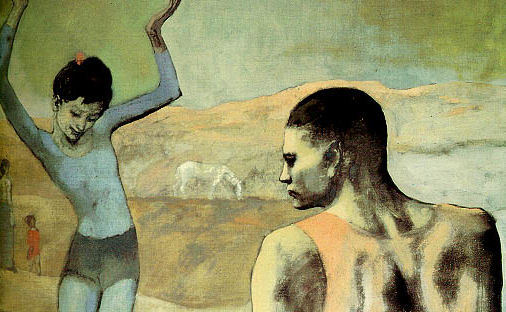




Why is it that the title of the Picasso immediately above these words is always some variation of The Acrobat? Yes, she's enchanting as she balances expertly on the ball which I've had to crop, but the entire painting is dominated by the figure in the foreground, aware of the female figure but entirely absorbed by the necessities of his own upcoming perforance.
This painting is one of my oft-visited treasures at Expo 67; it's unique, and so is Seinfeld, watched at an interval of almost forty years. And yet the two in my mind are inextricably linked, and any further analysis will only cloud the issue. Too much information is always worse than not enough.
________________________
The small strip from Feininger's The Edge of the World (taken from the website of the New York Times) was chosen for this page's Masthead partly because an exhibition of Feininger's works is coming to the Montreal Museum of Fine Arts from January 21 to May 13, 2012, and I intend to see the originals. Every picture without exception on these Sandsifter Five pages will benefit (as will its viewer) by a closer inspection on the website from which the uncropped original has been copied. Arranging to live in a city that has exhibitions of the works of unexpected artists will also help.
Rouault's Heads of Two Clowns, once seen in The Meaning and Magic of Art by Fred Gettings, Paul Hamlyn Ltd. 1963, Page 50, had to be included on this Page. Author Gettings includes this Picture with an Egyptian wall-painting and works by Braque, Lautrec and Sutherland under the heading black lines and circuses, the cryptic notation copyright S.P.A.D.E.M. PARIS 1963, and the information that the work forms part of the Norbert Schimmel Collection, but finding out the date of creation, measurements, and location of the original work seems to be impossible.
 Lyonel Feininger, The
Edge of the World
Lyonel Feininger, The
Edge of the World
 Edouard Manet,
Musée d'Orsay Online
Edouard Manet,
Musée d'Orsay Online ________________________